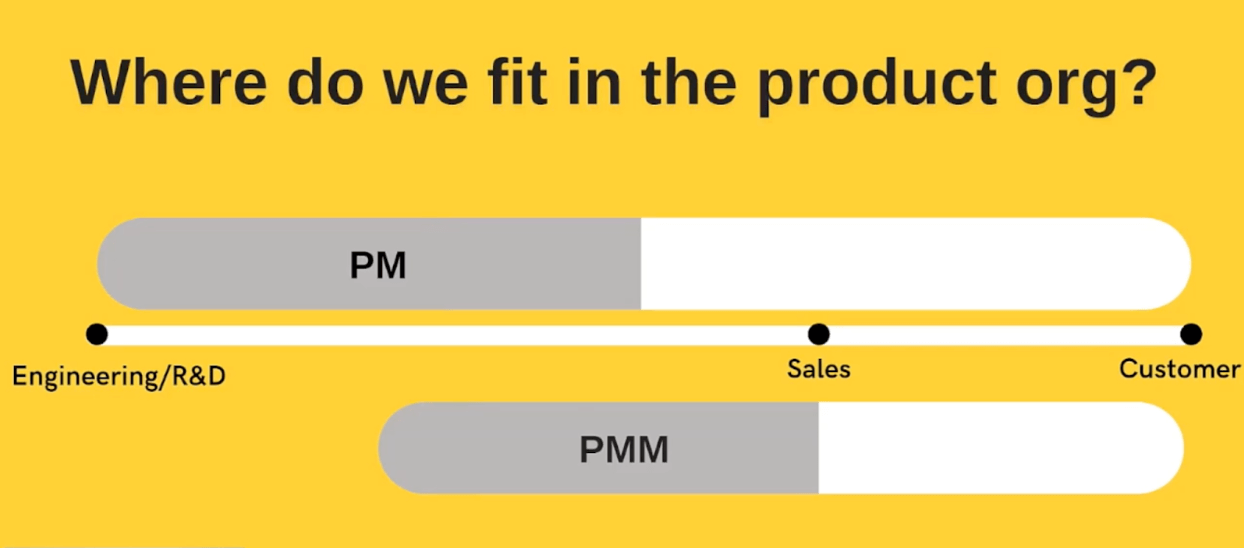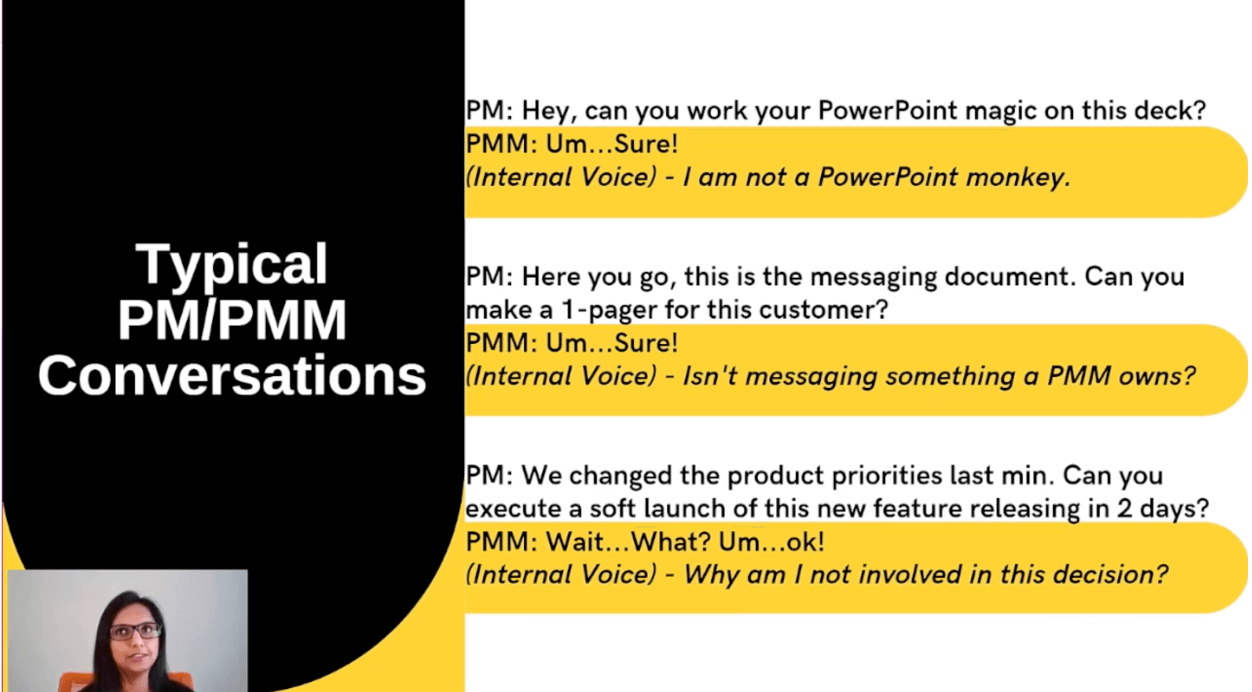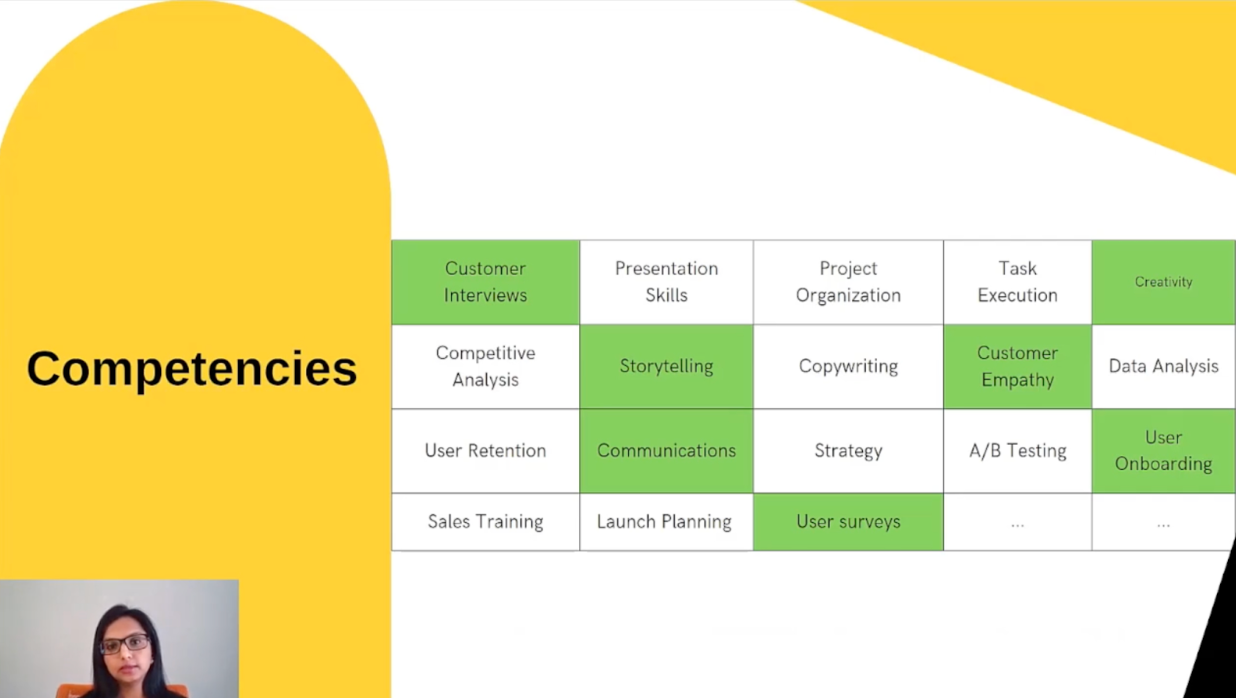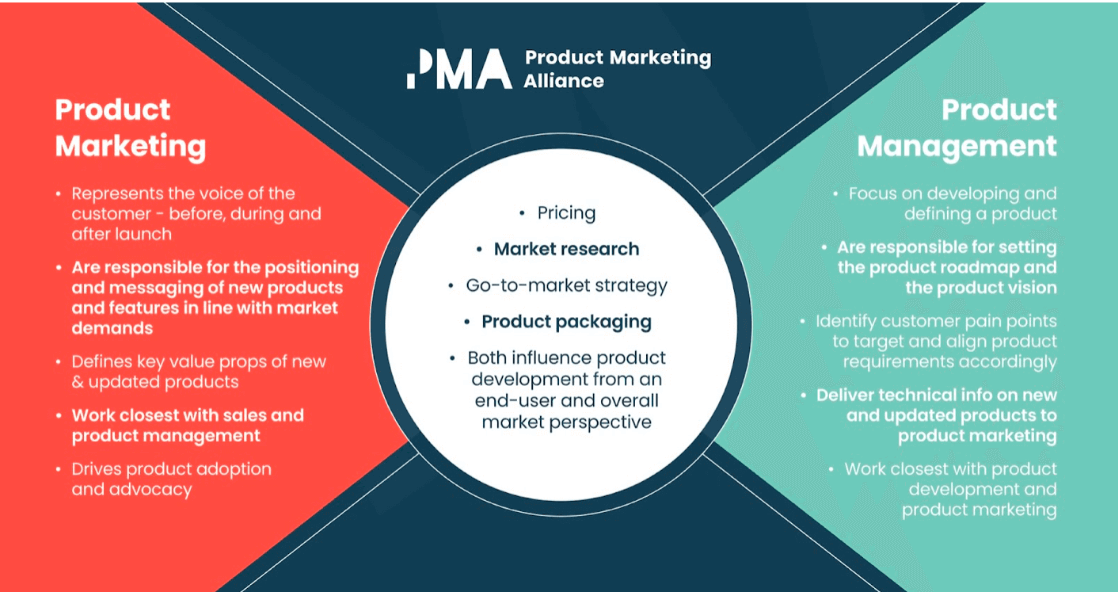As someone who transitioned into product marketing over the last 10 years, I've been on both sides of the product management and marketing divide – and sometimes I’ve had to lean into one role more than the other to get things done.
By spending time on both sides of the coin, I've developed some best practices I’d like to share on how to transform product management and marketing into the dream team.
I’ll be focusing specifically on:
- Where we fit in the product organization
- The life of a product manager
- Typical PM-to-PMM conversations
- Responsibilities vs. capabilities
- Three strategies for building a trusting relationship with your product manager
Where do we fit in the product organization?
Let’s start by looking at where product marketers and product managers fit into the product organization.
Broadly speaking, a Product Manager (PM) sits closer to the engineering and R&D side, whereas a Product Marketing Manager (PMM) sits closer to sales on the customer side of things. Sometimes the PMM could be working with customer success and other customer-facing teams as well.

But as you can see, the product manager's role type extends to the customer, and the product marketing role does too, so there’s a gray area where PM and PMM roles overlap. This is where the picture starts to get confusing, right?
As a simple example, a product manager needs to discover the product that needs to be built by engineering. To do this, they talk with the customer regularly to understand customer needs, they do the product discovery, figure out what needs to be built, and then they involve a product marketer to take this built product to market.
Similarly, in an ideal world, a product marketer is also talking with customers for market research to understand their pain points and to be able to message and position the products well.
If there’s a disconnect between the PM and the PMM, both of these roles end up talking with the customer at different points in time, frustrating the customer, getting different pieces of information, and building and launching the wrong product.
These issues can easily come up, and they do, all the time. That's when the questions around who exactly owns messaging and who owns go-to-market come into our lives.
It's a bit like the telephone game that we used to play as kids, where a phrase is whispered into the first person’s ear and passed down the line until the last person blurts out what they heard, and it's never the original phrase.
That's what happens when there are so many touchpoints throughout the organization. Before diving into how to solve these issues, I’d like to talk about the life of a product manager, so we can better understand their point of view.
The life of a product manager
Product managers are always thinking about the future state of the product. Where do we want the product to be in three to five years? To achieve that goal, what short-term strategy do we need to take?
Getting more granular, what milestones on our roadmap will lead us to our quarterly targets? Then they work in highly tactical bi-weekly sprints to fix, finalize, build, and launch specific features and capabilities.
More often than not, product marketers are involved in these bi-weekly sprints only when something is ready to be launched and needs to go to market. However, I would say that a product marketer needs to be involved at every stage.
The best way to get involved is to have an open conversation, ask a lot of questions, and be curious about the products that you're marketing. What’s the vision? Where are we going with this? We need to look at the big picture and distill it down to what we’re marketing and launching today.
Typical PM/PMM conversations
Now, here are some typical PM/PMM conversations. These are where a lot of misunderstanding tends to occur.
A PM could be working on a PowerPoint deck, and then they hand it off to you, asking you to work your magic on it. Your internal voice goes, “I'm not a PowerPoint monkey! I want to be involved in the strategy, the messaging, and the decisions around priority and cost.”

That’s what we want to try and minimize. I'm going to be very honest and say that what I’m going to tell you is not the be-all and end-all, but we can reduce these frustrating conversations and cut down the internal voice that’s eating you up inside.
Responsibilities vs. capabilities
The way to think about this is to move away from the traditional responsibilities model, where we say that product marketing owns messaging, product management owns the roadmap, product marketing owns go-to-market, and product management owns strategy.

Instead of seeing these responsibilities in black and white, I'd like to challenge you to think in terms of competencies. Now, some of these competencies could be the same, like competitive analysis, for example, but they are all skills that can be learned over time.
Customer interviews, for example, typically need to be done by both the PM and the PMM. Meanwhile, win-loss interviews are usually run by PMMs, while the PM tends to take charge of user research. But perhaps neither of you is particularly good at one of these skills, or one of you is better at the skill than the other. That’s where you must work together.
I would challenge you to go back to your desk and have a passionate conversation with your product manager to distill down the key competencies that you need to have between you to get things done. I’ve listed some of these skills below, but there may be more.
The skills in green are the ones that I'm really good at. I can show this list to my product manager, and they might be good at some of the other things like project organization, user retention, and sales training. Perhaps that's where we start to work on our weaker skills or hand over ownership of them to the stronger person.
Here's a really good breakdown by Product Marketing Alliance. The focus is on the middle part, which is an intersection between the two roles – that’s where I would challenge you to think about the competency model.

For example, if you're doing pricing, the competency you need is data analysis, so data analysis becomes a box in the competency model. You then have to ask yourself, as a product marketer, am I competent enough in this skill to take it and run with it?
To build a healthy and trusting relationship, you need to be okay with handing pricing over to your product manager if you think you don’t have enough experience in that area.
Three strategies for building a trusting relationship with your Product Manager
Let’s look at three strategies that will help you build that trust, get that relationship going, and take it to the next level.
1) Partnership
Let’s start with partnership. I’d like you to think of partnership as a handshake, not a handoff. For this to be an iterative process, you need to build trust with your counterpart.
There’s no shortcut to this; it’s not going to be easy, but you'll have to have that conversation. Sit down with your PM, figure out where your strengths lie and identify areas for improvement.
From there, you can begin to peer mentor each other and develop your skills. There’ll be lots of things that your new partner is really good at and that they can teach you in this partnership.
2) Ownership
The second aspect is ownership. This is all about being proactive and picking an area to own.
Let's say you want to own pricing; there’s a list of competencies that you need to have, including data analysis, as we discussed. If that’s something that you want to go deep into, you need to proactively let your product manager know that you want to develop competency in this area.
You need to have a breadth of experience and knowledge as a product marketer, but you also need to be known for one area of expertise. Be your PM’s go-to person for that, so they know they can rely on you to get it done.
The final part of the ownership strategy is learning to say no. I know it’s easier said than done, but it’s best to stay away from those random one-off acts of marketing that you're asked to perform. Keep those tasks to a minimum level, and continue on your path of evolution as a product marketer.
3) Sinking others’ ships
The last piece is sinking others’ ships. This is all about tackling competition. Competitive analysis is an area that both product management and product marketing need to stay on top of.
Product managers are looking at competitive analysis from a product feature perspective, but for us product marketers, it's more from a messaging and market positioning point of view. Having a common enemy, aligned OKRs, and a shared competitive analysis project will help you build a great relationship.
As you're working on this project together, I'm pretty sure you'll run into conflict – that’s natural. My advice, negotiation 101, is to separate the person from the problem and focus on the project in front of you. Again, I know it’s easier said than done, but if you're inspired to take your relationship with your product manager to the next level, this is where I would start.
Key takeaways
To summarize what I’ve talked about today, I’d like to leave you with three key takeaways.
- A little empathy towards your PM goes a long way. You don't know how their day is going or why they're asking you to do certain things, so build that trusting relationship and have a little empathy.
- Identify individual competencies. To move into the competency model thinking, have an open conversation, identify your strengths, and operate from there. Take ownership or develop a partnership where appropriate. Take the things you want to hone in on and build ownership in that area. It's a lot of hard work, but it’s worth it if that’s what you want to do. Lastly, partner with your PM in areas where you can leverage their expertise.


















 Follow us on LinkedIn
Follow us on LinkedIn



.svg?v=1abcb94374)